Bulletin – September 2018 Australian Economy Firm-level Insights into IT Use
- Download 402KB

Abstract
Firms in Australia have used advances in information and communication technology (IT) to become more productive, reduce costs, and improve their understanding of customers. The rate at which new technology has been adopted by firms differs greatly, as do the benefits from using IT. The way firms are using IT can help to explain trends in the broader economy. Firms' expenditure on computer software has grown faster than other forms of investment. The adoption of new technology is also changing the composition of jobs in the economy.
Introduction
The effect of advances in technology on firms' operations has been a common topic of discussion with firms in the Reserve Bank's business liaison program in recent years.[1] This article draws on discussions with firms in the Bank's business liaison program over the past two years on their use of information and communication technology (IT).[2] These liaison meetings cover a wide range of industries, and include discussions with some of the major suppliers of IT services, equipment and software that operate in Australia. The themes identified from discussions with firms are complemented by information from the Australian Bureau of Statistics (ABS), including the ‘Business Use of Information Technology Statistics’ release that covers a larger number of firms than the Bank's liaison program.
Information from the Bank's liaison program and other survey evidence suggest firms have been more willing to spend on IT than most other forms of capital in recent years (Graph 1). The desire to increase efficiency, lower the cost of doing business, and improve service quality have been important drivers of the adoption of technology across the economy. Software has become the primary technological focus for many firms, and businesses increasingly acquire technology as an operating, rather than capital, expense. At the same time, IT use can vary greatly between firms, even in the same industry, as can the realised benefits. Firm size also appears to be an important determinant of the type and extent of technology used.
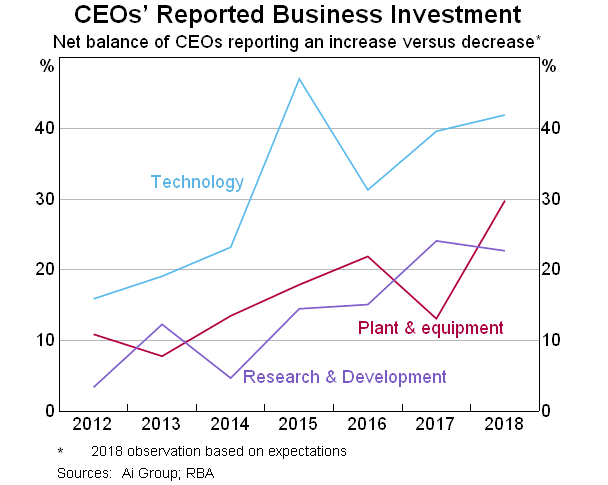
Several insights generated from the study of IT use by firms have implications for our understanding of the economy. The wide range of IT experiences firms have had means that sectoral and economy-wide analyses may mask important economic effects at the firm level which could help to explain macroeconomic trends. For example, the use of IT has been cited as a possible driver of important trends in the labour market. Discussions with firms suggest that the adoption of more advanced IT changes the type of skills required, but does not necessarily change the number of jobs available. IT expenditure has also been a driver of trends in aggregate investment.
Trends in Technology Investment
IT refers to the equipment and software that firms and individuals use to manage and communicate information and data. According to estimates from the ABS, firms in Australia invested around $35 billion in IT in 2016/17 (2 per cent of GDP), of which around three-fifths was on software (Graph 2).
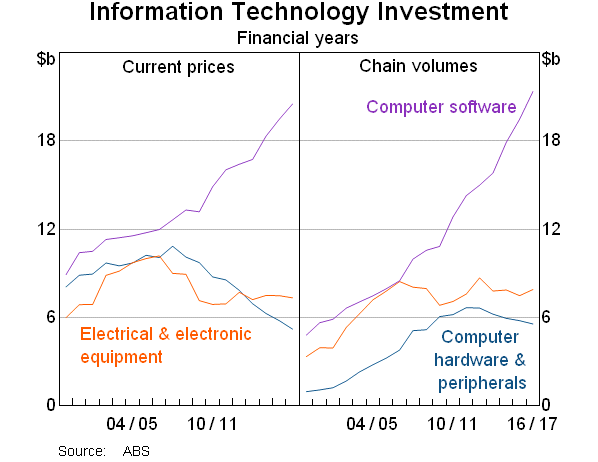
The increasingly important role of technology use by Australian firms is evident in changes in the composition of business investment. Over the past few decades, and particularly since 2009/10, non-mining business investment in intellectual property, which includes computer software, has grown noticeably faster than investment in building & structures and machinery & equipment (Lowe 2018a). Moreover, information from firms suggests that IT has had a more pervasive influence on investment than direct estimates of IT investment would suggest. A growing share of the value of a wide range of capital goods may be attributed to the built-in IT components (both hardware and software). For example, investment in robotic or autonomous equipment by firms would be captured as industrial or transport machinery & equipment investment. More broadly, technological change underlies much of the shift in industry composition and changes in the types of investment undertaken over time (see van der Merwe et al (2018)).
Investment in IT enables firms to perform existing tasks and processes more efficiently, but also enables them to develop new products and services. For example, gaining access to high-speed or mobile internet services has become important for the vast majority of firms, as it has for individuals, due to the speed and access to information such services provide (Graph 3). Similarly, the same social media tools used by individuals have become an important way for many firms to communicate with their clients and customers, and also internally between employees. Some other technologies that are increasingly being used by Australian firms include:
- Cloud computing: IT services that provide access to software, computing power or storage capacity via the internet, rather than relying on servers or computers housed at the firm.
- Software for business processes: Specialised software to help manage and maintain aspects of running the business. Common forms include: Enterprise resource planning (ERP) software to facilitate back-office processing of invoices, inventory management and staff functions; e-commerce platforms, such as online stores; and digital marketing software.
- Data analytics: The process of examining data sets to draw conclusions about the information they contain. The underlying data are sometimes referred to as ‘big data’ if the data sets are very large, frequently updated and consist of a variety of data types.
- Artificial intelligence (AI): Computer systems designed to replicate the characteristics of human intelligence and judgement, typically specialising in a well-defined task.[3] Applications include intelligent software systems, autonomous vehicles and Google's search algorithms. Machine learning is a specific type of AI where machines are given access to data to learn independently.
- Internet of things: A network of devices embedded with technology (such as home appliances and cars connected to the internet) that are able to connect and exchange data.
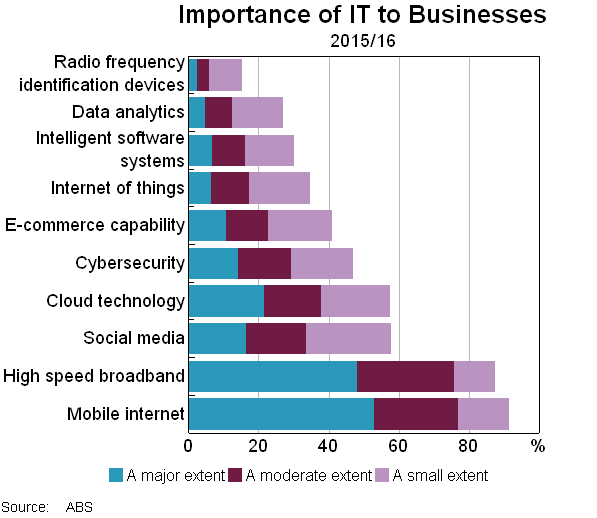
Key Themes from Liaison
Discussions with medium and large firms in the Bank's business liaison program reveal four themes in Australian firms' use of technology: a shift towards outsourcing and changes in how firms account for IT expenses; the automation of back-office processing; differences in IT use by firm size; and differences in IT use between industries.
Outsourcing and the shift to operating expenses
Many firms have outsourced at least a portion of IT services and also changed the way they account for IT expenses. The increase in complexity and rate of change in IT has led some firms to outsource the provision of some or all of their technology requirements, rather than sustain the internal expertise required to maintain systems. Common drivers of outsourcing are convenience and cost minimisation. Outsourcing gives firms the ability to pay only for what they use, rather than make large upfront investments and acquire additional (spare) capacity to cover expected future requirements. Outsourcing often entails a change in the accounting treatment of firms' IT spending from capital expenditure (capex) to operating expenditure (opex). Managers sometimes cite the switch to opex as an additional benefit of outsourcing and in turn structure the acquisition of other IT services as opex.[4]
The increase in the use of cloud computing in recent years reflects both the trend toward outsourcing and accounting for IT spending as opex. Many medium and large firms in the Bank's liaison program have either ‘shifted to the cloud’ or are considering doing so. Consistent with these messages, ABS survey data point to a large increase in the prevalence of cloud use in some industries in recent years, with around one-half of firms in the professional services and finance industries and close to three-fifths of firms in the information media & telecommunications industry using a cloud service in 2015/16 (Graph 4).
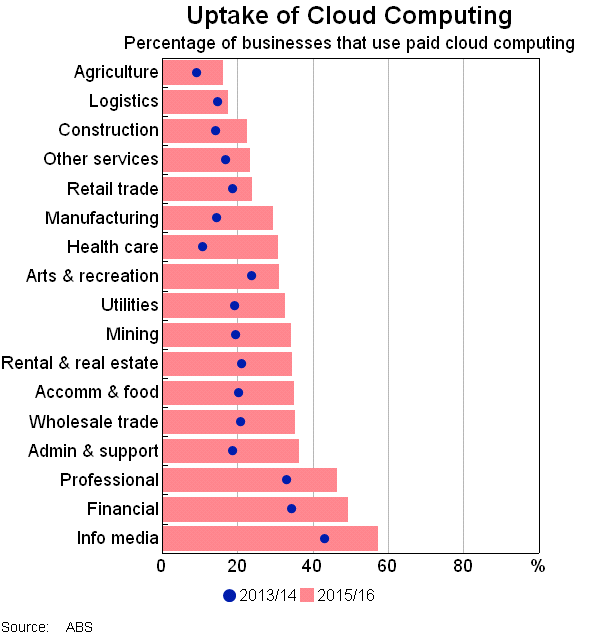
The automation of back-office processing
Automation of back-office processes and tasks has been a core objective of firms' IT strategies for many years. The routine, labour-intensive nature of tasks such as basic accounting, invoicing and payroll make these obvious activities for IT applications. The homogeneous nature of these tasks across industries means that many of the underlying IT tools required to automate these processes are well developed and readily accessible. ERP software is generally at the centre of firms' IT strategies for automating business processes, but implementation can be difficult and costly – particularly for small firms. The extent of automation observed among firms in the business liaison program varies considerably, from standalone software applications for single processes through to fully digital solutions incorporating AI and machine learning.
ERP systems can incorporate a wide range of IT functions, such as Customer Relationship Management software, data analytics and mobile solutions. For firms in the liaison program, ERP systems have often been a precursor to the outsourcing and offshoring of remaining manual tasks, as a way of reducing labour costs. More recently, advances in software have allowed an increased range of processes to be automated to the point where previously offshored tasks may now be automated more cost effectively instead. For example, incoming invoices may now be processed by software rather than by a person.
Firms in the business liaison program indicate that labour cost savings and better access to information are key benefits from automating back-office tasks. However, automation does not necessarily result in a net reduction in headcount; many firms observe that labour cost savings on routine back-office tasks are then used to expand labour resources in other roles (sometimes by retraining those affected by the automation). Better access to information, both in terms of breadth and time to access, is another key benefit of automation. Faster processing times and reduced error rates are also benefits. Firms often refer to the advantage of ‘end-to-end visibility’ of their organisation afforded by a well-implemented ERP system. This allows more informed decisions to be made, further reducing costs and increasing utilisation of existing capacity. Firms that have replaced offshore options with AI and machine learning report the advantages of further reductions in labour costs and the elimination of risks associated with offshore operations. More generally, firms cite increased data generation and available analytics (such as pattern and fraud detection) as benefits of this technology.
IT use differs by firm size
The size of businesses appears to have a strong bearing on the types of technology adopted (Graph 5). ‘Standard’ established technology, such as internet access, is important to most small businesses, and many smaller businesses are shifting to the cloud. However, other more sophisticated technologies are not yet viewed as important by the majority of small businesses. In contrast, large businesses view most types of IT as important.
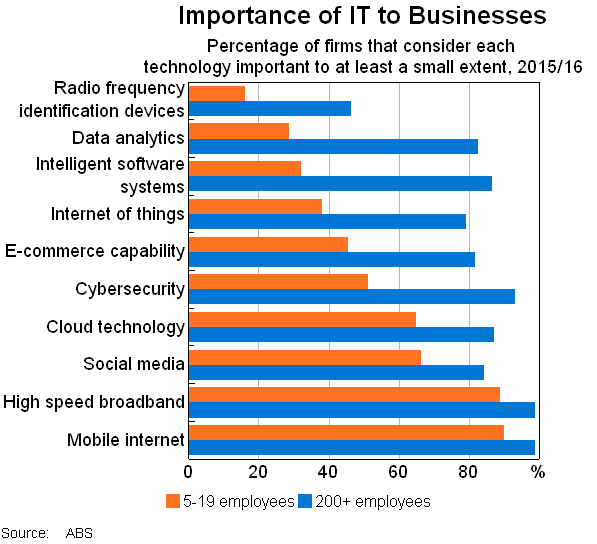
Differences in the use of IT by small and large businesses could be due to a few factors. Small firms may not have the ability or sufficient economies of scale to be able to successfully implement some types of technology. Introducing technology has traditionally required an upfront investment in hardware and software as well as staff training, and changes in business processes that may take several years to implement. Other challenges reported by firms in implementing new IT systems include resistance from employees, difficulties finding people with the required IT skills, and immature technology. For smaller firms, the expected benefits in terms of lower labour costs and higher productivity may not be sufficiently large to justify the investment and disruption to business processes. However, over time, the case for small firms to invest in more sophisticated IT is expected to strengthen as technology matures and costs decrease. The shift to the cloud and software as a service (or ‘SaaS’) may also assist in reducing the upfront costs of adopting technology that were previously prohibitive for small firms.[5]
The importance of firms' scale in shaping the benefits of technology is demonstrated by differences in the adoption of autonomous equipment between mining operations. The major iron ore producers in Australia are among the global leaders in their adoption of autonomous mining equipment, such as driverless trucks, reflecting the large scale, open-cut and very long-lived nature of their operations. In contrast, the adoption of autonomous equipment at many other mining operations in Australia is in its infancy. Information from firms suggests that the expected benefits of autonomous equipment at these operations are limited by short expected life of mines, constantly changing or complex mine conditions, and small-scale operations. However, industry participants are generally positive about future expansion of automated mining equipment, as the costs of purchasing autonomous equipment fall and new mines are designed with autonomous equipment in mind.
IT use differs between industries
Firms across all sectors are looking to use technology to lower costs, improve productivity and improve their ability to compete. However, there are sectoral differences in the types of technologies being adopted to achieve these goals, reflecting that some technologies are more relevant to certain activities than others. For example, social media is more relevant for firms in sectors looking to target individual customers, such as the accommodation & food sector, than for firms in the mining or agricultural sectors, which sell bulk commodities to the global market (Graph 6). Further, some sectors are more ‘tech savvy’ than others; unsurprisingly, the information media & telecommunications sector is a leading adopter of almost all types of technology.
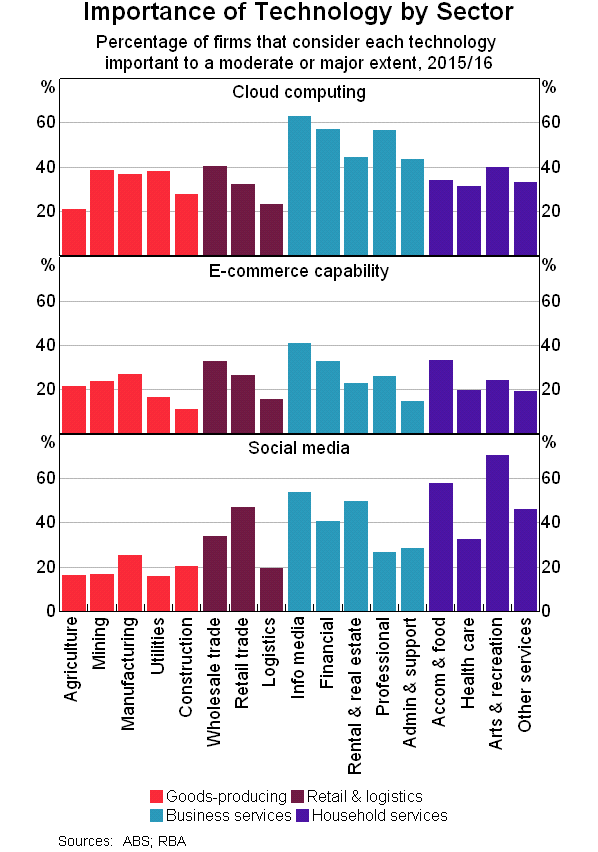
Firms in goods-producing industries, such as agriculture, mining and manufacturing, are generally looking to use technology to lower costs and improve productivity in response to global competition. Firms in these sectors often report investing in advanced technologies such as autonomous equipment and predictive maintenance systems. In contrast, firms in the domestically oriented construction industry generally report investing in software systems that improve the efficiency of the design and construction process and digital marketing to attract sales. Investment in autonomous equipment is not a priority in on-site construction due to the complex and changing conditions on building sites.
Many firms in the retail sector are using technology to lower costs, improve the customer experience, and increase sales. Competition in the retail sector has intensified over the past decade, with online retailers and foreign entrants putting pressure on prices and margins of traditional bricks-and-mortar stores (Ballantyne and Langcake 2016). Examples of technologies used include rostering software, digital marketing and payment platforms to improve the customer experience, and data analytics to better understand consumer behaviour. Logistics firms are focused on using technology to improve productivity and lower costs; investment in automation at warehouses and fleet management systems has become increasingly common. Similarly to retailers, firms in the labour-intensive business and household services industries are generally looking to use technology to reduce labour costs and improve their services. Business services firms in areas such as accounting and legal services are facing competition for their core services from AI and are looking to provide ‘value-adding’ activities, such as data analytics of clients' data.
Potential Implications for the Australian Economy
Information from firms suggests that technological change has affected business operations in many different ways and, in turn, has influenced underlying macroeconomic variables such as employment, wages growth and investment. However, the expected effects of IT use and investment are not always easy to identify in the macroeconomic data, possibly reflecting the wide variation in IT use and benefits across firms.
The trend towards outsourcing is likely to have had a moderating effect on aggregate IT investment in Australia (all else being equal), particularly if the underlying investment needed to provide firms' operational technology requirements is done more efficiently by IT services firms or is conducted offshore. Offsetting this effect, introducing new technologies, for instance by automating business processes or establishing online customer service platforms, tends to involve large upfront capital costs. As noted in van der Merwe et al (2018), some structural factors – including technological developments – have contributed to the decline in the share of non-mining investment over recent decades, and may have ongoing effects.
Employment
Firms in the Bank's liaison program generally do not expect IT investment to significantly lower their firm's headcount over the next few years. Some companies envisage that headcount will decline over a longer time period because the process of technology adoption occurs only gradually. However, many other firms expect technology adoption to change the composition of their workforce rather than reduce headcount, with jobs shifting from routine, manual tasks to higher value-adding tasks.
Firms report that the roles being displaced by technology typically involve routine tasks where technology can most easily substitute for workers, or roles where technology has changed the nature of business operations. Such roles include back-end corporate tasks, front-line sales workers, call centre operators, routine manual labourers and IT infrastructure administrators. In some cases, role displacement leads to the exit of employees, but in many other cases at least some affected employees are retained through retraining and taking on different tasks. The roles commonly cited by liaison contacts as being created by technology tend to be IT-related, including software analysts & developers, business intelligence analysts, data analysts and digital marketing content creators. This is consistent with ABS Census data showing strong growth in IT employment over the past decade (Graph 7).
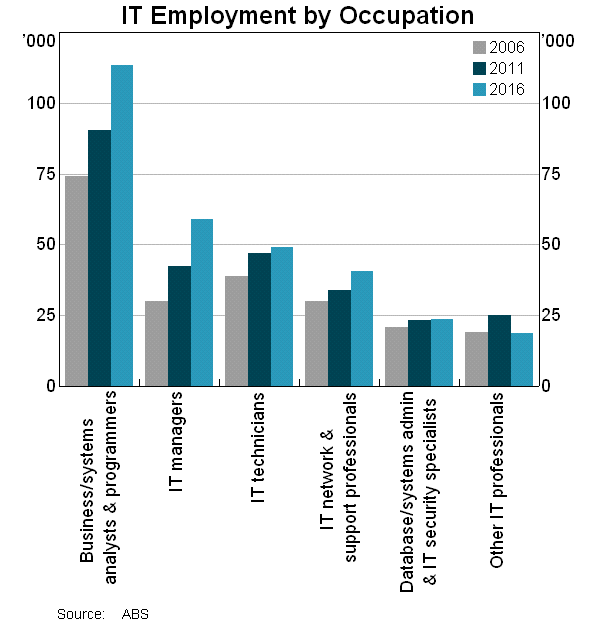
Reports from liaison on the types of jobs being created and displaced by technology are consistent with the compositional changes in aggregate employment observed in the Australian labour market over recent decades. During this period, employment has shifted away from occupations involving routine tasks to those with non-routine tasks (Borland and Coelli 2017; Heath 2017).[6] Non-routine cognitive employment has increased most strongly over recent years, followed by non-routine manual employment (Graph 8).[7] Technological change has been an important driver of these trends, enabling many routine tasks to be offshored or automated while creating demand for more complex skill sets. Indeed, the job-creating effects of technology are emphasised heavily in the academic literature. For example, the creation of new, labour-intensive tasks is argued to have an important counterbalancing influence on the labour displacement effects of automation (Acemoglu and Restrepo 2018). Borland and Coelli (2017) find no evidence that the adoption of computer-based technologies has reduced the aggregate quantity of work available in Australia.
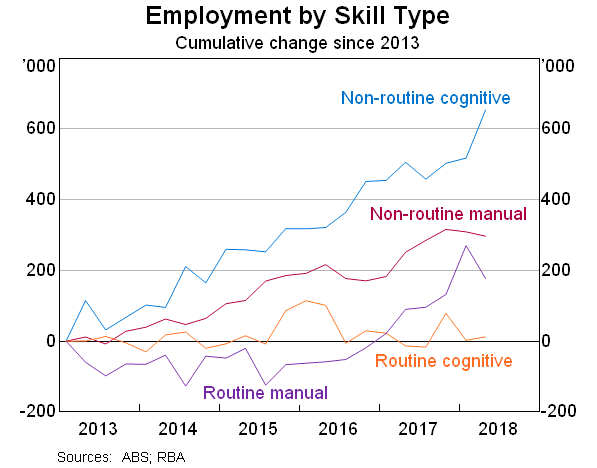
The role of technological change in creating demand for more highly skilled workers is leading to wage pressure for some skill sets. Liaison contacts commonly report that it is difficult to find workers to fill specialised IT and digital roles. Consequently, workers in these roles have received higher wage increases than most other types of workers due to the strong demand and relative scarcity of these skills at present.
Productivity
Despite the strong message from liaison that firms are investing in technology to increase productivity and efficiency, this has not been matched by measured labour productivity growth, which has been slower than in the 1990s and early 2000s (Graph 9). This slowdown in productivity growth has been observed across many advanced countries (OECD 2017). Potential explanations being debated globally include: issues with the measurement of new products and technologies in GDP; implementation lags or a slowing of the pace at which innovation spreads from the most to the least productive firms; a shift in industry composition towards the services sector which has lower measured productivity growth; and recent technological innovations having a smaller impact on productivity than past innovations such as the steam engine, electricity or computers (Adler et al 2017; Andrews, Criscuolo and Gal 2015; Brynjolfsson, Rock and Syverson 2017; Gordon 2015; Productivity Commission 2017; Syverson 2017).
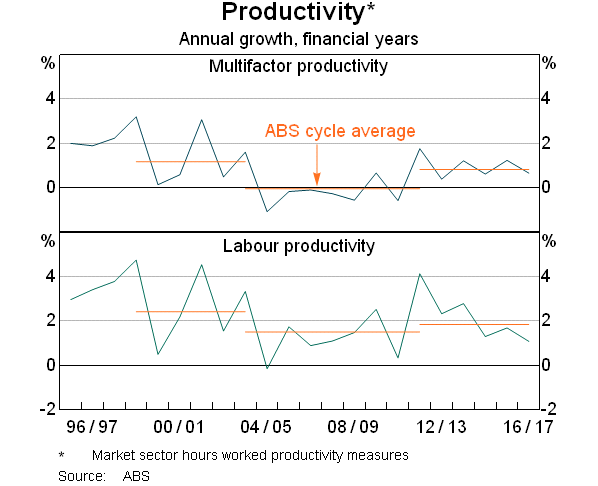
The information from firms in the liaison program provides support for the explanations based on implementation lags and a slow spread of innovation from the most to the least productive firms. That is not to say that some of the other explanations are not also important. To take advantage of technologies such as AI and machine learning, firms need to invest in significant capital, change business processes, and train staff in techniques that require strong quantitative and analytical skills. All of this can be very challenging and it can take years to reap the expected benefits. Further, many small firms are lagging well behind large firms in their adoption of this type of technology in Australia. Over time, the diffusion of new technology throughout the economy would be expected to boost aggregate productivity and lift real wages (Lowe 2018b).
Prices
Many liaison contacts do not expect the adoption of technology to have a significant impact on their prices over the next few years. However, once adoption becomes more widespread, competition is generally expected to drive prices lower for more homogenous products. Other firms believe that instead of lowering prices, they would be able to use technology to differentiate their product or service from their competitors' product or service and keep their prices unchanged.[8] The degree of competition in a market will generally determine whether the lower costs achieved through technology are passed on to customers through lower prices or used to increase margins. Analysis by other central banks does not generally support the proposition that technology has had a significant negative impact on inflation in recent years (Charbonneau et al 2017; ECB 2015; Sveriges Riksbank 2015).
Conclusion
IT is a priority area of spending for many Australian firms, with implications for labour, investment, and productivity in the Australian economy. However, it can be hard to disentangle the impact of technology from other cyclical and structural changes affecting the economy. Firm-level information from the Bank's liaison program and ABS surveys highlight several common themes in firms' adoption of technology. Many firms expect the adoption of technology to change the composition of their workforce rather than reduce headcount, with jobs shifting from routine, manual tasks to higher value-adding tasks. Many firms have also outsourced the provision of their IT requirements due to the increasing complexity and rate of change in technology.
There are also significant differences in IT use between firms of different sizes and industries. Notably, the adoption rate of more sophisticated technologies is much lower among small firms compared with large firms. The slow spread of technological innovation between firms and implementation lags could help explain why technological advancements have not yet resulted in faster productivity growth.
Footnotes
The authors are from Economic Group. The authors would like to thank colleagues in the Regional and Industry Analysis section, and Adam Gorajek and Rochelle Guttmann for their input and comments. [*]
The Reserve Bank's business liaison team conducts around 70–80 discussions each month with firms, agencies and community groups. Liaison meetings are held nationally with firms of all sizes, though most discussions are with mid-sized and large firms where conditions are somewhat more likely to reflect economy-wide trends rather than firm-specific factors. For more information, see RBA (2014). [1]
See Manalo and Orsmond (2013) for a discussion of the impacts of technological advancements on the business services sector, based on earlier liaison information. [2]
Also referred to as artificial ‘narrow’ intelligence, in contrast to artificial ‘general’ intelligence, which is a hypothetical substitute for general human mental capability (the ability to reason, plan, solve problems, think abstractly, comprehend complex ideas, and learn from experience). [3]
Reported benefits of the switch to opex include fewer non-income generating assets on the firm's balance sheet, and lower depreciation charges. While firms may internally account for their IT spending as opex, the ABS attempts to capture all expenditure on intangibles (including computer software) as capex in the national accounts. In practice, the classification of spending in the national accounts depends on how firms report this expenditure in business surveys. [4]
SaaS is a software distribution model that allows customers to access applications from a third-party provider via the internet. [5]
Autor, Levy and Murnane (2003) define routine tasks as a limited and well-defined set of activities that can be accomplished by following explicit rules, while non-routine tasks involve problem-solving and complex communication activities. They argue that technology is a substitute for workers carrying out routine tasks but complements workers in performing non-routine tasks. [6]
Non-routine cognitive occupations include most managers, professionals and engineering, IT & science technicians. Non-routine manual occupations include community & personal service workers and food trades workers. Routine cognitive occupations include clerical & administrative and most sales workers, while routine manual occupations are comprised mainly of machinery operators & drivers, labourers, and some technicians & trades workers. [7]
To the extent that the new product or service contained measurable quality improvements, this should be captured in the consumer price index (CPI) as a reduction in price. The CPI aims to measure price changes for a fixed basket of goods and services excluding changes in quality. [8]
References
Acemoglu D and P Restrepo (2018), ‘Artificial Intelligence, Automation and Work’, NBER Working Paper No 24196.
Adler G, R Duval, D Furceri, S Kiliç Çelik, K Koloskova and M Poplawski-Ribeiro (2017), ‘Gone with the Headwinds: Global Productivity’, IMF Staff Discussion Note SDN/17/04.
Andrews D, C Criscuolo and PN Gal (2015), ‘Frontier Firms, Technology Diffusion and Public Policy: Micro Evidence from OECD Countries’, OECD Productivity Working Papers No 2.
Autor D, F Levy and R Murnane (2003), ‘The Skill Content of Recent Technological Change: An Empirical Investigation’, Quarterly Journal of Economics, 118(4), pp 1279–1333.
Ballantyne A and S Langcake (2016), ‘Why Has Retail Inflation Been So Low?’, RBA Bulletin, June, pp 9–17.
Borland J and M Coelli (2017), ‘Are Robots Taking Our Jobs?’, Australian Economic Review, 50(4), pp 377–397.
Brynjolfsson E, D Rock and C Syverson (2017), ‘Artificial Intelligence and the Modern Productivity Paradox: A Clash of Expectations and Statistics’, NBER Working Paper No 24001.
Charbonneau K, A Evans, S Sarker and L Suchanek (2017), ‘Digitalization and Inflation: A Review of the Literature’, Bank of Canada Staff Analytical Note 2017–20.
ECB (European Central Bank) (2015), ‘Box 6: Effects of E-commerce on Inflation’, Economic Bulletin, Issue 2, pp 51–54.
Gordon RJ (2015), ‘Secular Stagnation: A Supply-Side View’, The American Economic Review, 105(5), pp 54–59.
Heath A (2017), ‘Skills for the Modern Workforce’, Remarks to the Victorian Career Advisors Conference, Melbourne, 1 December.
Lowe P (2018a), ‘The Changing Nature of Investment’, Address to the Australian Financial Review Business Summit, Sydney, 7 March.
Lowe P (2018b), ‘Productivity, Wages and Prosperity’, Address to Australian Industry Group, Melbourne, 13 June.
Manalo J and D Orsmond (2013), ‘The Business Services Sector’, RBA Bulletin, March, pp 1–10.
OECD (Organisation for Economic Cooperation and Development) (2017), OECD Compendium of Productivity Indicators, OECD Publishing, Paris.
Productivity Commission (2017), ‘Productivity and Income – The Australian Story, Shifting the Dial: 5 Year Productivity Review, Supporting Paper No. 1’.
RBA (Reserve Bank of Australia) (2014), ‘The RBA's Business Liaison Program’, RBA Bulletin, September, pp 1–5.
Sveriges Riksbank (2015), ‘Digitisation and Inflation’, Monetary Policy Report, February, pp 55–59.
Syverson C (2017), ‘Challenges to Mismeasurement Explanations for the US Productivity Slowdown’, Journal of Economic Perspectives, 31(2), pp 165–186.
van der Merwe M, L Cockerell, M Chambers and J Jääskelä (2018), ‘Private Non-mining Investment in Australia’, RBA Bulletin, June, viewed 2 July 2018.